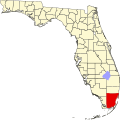2010 and 2020 census
As of the 2020 United States census, there were 5,030 people, 1,499 households, and 1,284 families residing in the CDP. [11]
As of the 2010 United States census, there were 5,253 people, 1,567 households, and 1,443 families residing in the CDP. [12]
2000 census
As of the census [3] of 2000, there were 5,460 people, 1,630 households, and 1,449 families residing in the CDP. The population density was 7,885.2 inhabitants per square mile (3,044.5/km2). There were 1,656 housing units at an average density of 2,391.6 per square mile (923.4/km2). The racial makeup of the CDP was 93.0% White (33.2% were Non-Hispanic White), [13] 0.8% African American, 0.2% Native American, 0.6% Asian, 3.2% from other races, and 2.3% from two or more races.
As of 2000, there were 1,630 households, out of which 43.3% had children under the age of 18 living with them, 72.5% were married couples living together, 11.2% had a female householder with no husband present, and 11.1% were non-families. 8.3% of all households were made up of individuals, and 3.1% had someone living alone who was 65 years of age or older. The average household size was 3.33 and the average family size was 3.49.
In 2000, in the CDP, the population was spread out, with 27.4% under the age of 18, 6.4% from 18 to 24, 31.8% from 25 to 44, 23.4% from 45 to 64, and 11.0% who were 65 years of age or older. The median age was 36 years. For every 100 females, there were 96.1 males. For every 100 females age 18 and over, there were 93.4 males.
In 2000, the median income for a household in the CDP was $62,161, and the median income for a family was $64,428. Males had a median income of $39,886 versus $28,281 for females. The per capita income for the CDP was $20,383. About 3.6% of families and 4.4% of the population were below the poverty line, including 2.1% of those under age 18 and 15.9% of those age 65 or over.
As of 2000, speakers of Spanish as a first language accounted for 6.18% of residents, while English made up 93.82% of the population. [14]


